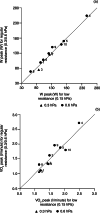Maximal cardiopulmonary exercise testing in laryngectomised patients using different heat and moisture exchangers - feasibility and exercise responses
- PMID: 37340780
- PMCID: PMC10849895
- DOI: 10.1017/S0022215123001068
Maximal cardiopulmonary exercise testing in laryngectomised patients using different heat and moisture exchangers - feasibility and exercise responses
Abstract
Objective: After laryngectomy, the breathing resistance of heat and moisture exchangers may limit exercise capacity. Breathing gas analysis during cardiopulmonary exercise testing is not possible using regular masks. This study tested the feasibility of cardiopulmonary exercise testing with a heat and moisture exchanger in situ, using an in-house designed connector. Additionally, we explored the effect of different heat and moisture exchanger resistances on exercise capacity in this group.
Methods: Ten participants underwent two cardiopulmonary exercise tests using their daily life heat and moisture exchanger (0.3 hPa or 0.6 hPa) and one specifically developed for activity (0.15 hPa). Heat and moisture exchanger order was randomised and blinded.
Results: All participants completed both tests. No (serious) adverse events occurred. Only four subjects reached a respiratory exchange ratio of more than 1.1 in at least one test. Maximum exercise levels using heat and moisture exchangers with different resistances did not differ.
Conclusion: Cardiopulmonary exercise testing in laryngectomees with a heat and moisture exchanger is feasible; however, the protocol does not seem appropriate to reach this group's maximal exercise capacity. Lowering heat and moisture exchanger resistance does not increase exercise capacity in this sample.
Keywords: Laryngectomy; exercise training; head and neck cancer.
Conflict of interest statement
None declared
Figures



Similar articles
-
Comparative ex vivo study on humidifying function of three speaking valves with integrated heat and moisture exchanger for tracheotomised patients.Clin Otolaryngol. 2015 Dec;40(6):616-21. doi: 10.1111/coa.12426. Clin Otolaryngol. 2015. PMID: 25823941
-
Effects of heat and moisture exchangers on minute ventilation, ventilatory drive, and work of breathing during pressure-support ventilation in acute respiratory failure.Crit Care Med. 1996 Jul;24(7):1184-8. doi: 10.1097/00003246-199607000-00020. Crit Care Med. 1996. PMID: 8674333 Clinical Trial.
-
Efficacy of heat and moisture exchangers after changing every 48 hours rather than 24 hours.Crit Care Med. 1998 Mar;26(3):477-81. doi: 10.1097/00003246-199803000-00018. Crit Care Med. 1998. PMID: 9504575 Clinical Trial.
-
The physiological rationale of heat and moisture exchangers in post-laryngectomy pulmonary rehabilitation: a review.Eur Arch Otorhinolaryngol. 2006 Jan;263(1):1-8. doi: 10.1007/s00405-005-0969-3. Epub 2005 Jul 7. Eur Arch Otorhinolaryngol. 2006. PMID: 16001247 Review.
-
[A new heat and moisture exchanger, Trach-Vent Plus, for patients with spontaneous respiration].Masui. 2003 Apr;52(4):417-9. Masui. 2003. PMID: 12728496 Review. Japanese.
References
-
- Head and Neck Cancers - National Cancer Institute. In: https://www.cancer.gov/types/head-and-neck/head-neck-fact-sheet [6 October 2021]
-
- American Head & Neck Society. Patient Education from the AHNS. In: https://www.ahns.info/resources/education/patient_education/ [6 October 2021]
-
- Hilgers FJ, Ackerstaff AH, Aaronson NK, Schouwenburg PF, Van Zandwijk N. Physical and psychosocial consequences of total laryngectomy. Clin Otolaryngol Allied Sci 1990;5:421–5 - PubMed
-
- Ackerstaff AH, Hilgers FJ, Aaronson NK, Balm AJ, van Zandwijk N. Improvements in respiratory and psychosocial functioning following total laryngectomy by the use of a heat and moisture exchanger. Ann Otol Rhinol Laryngol 1993;102:878–83 - PubMed
-
- Barbet JP, Chauveau M, Labbé S, Lockhart A. Breathing dry air causes acute epithelial damage and inflammation of the guinea pig trachea. J Appl Physiol (1985) 1988;64:1851–7 - PubMed
MeSH terms
LinkOut - more resources
Full Text Sources

